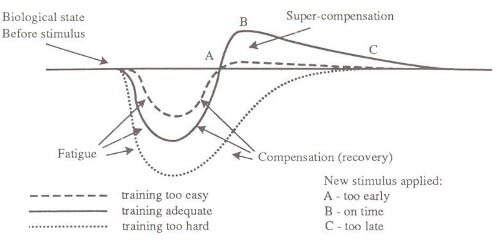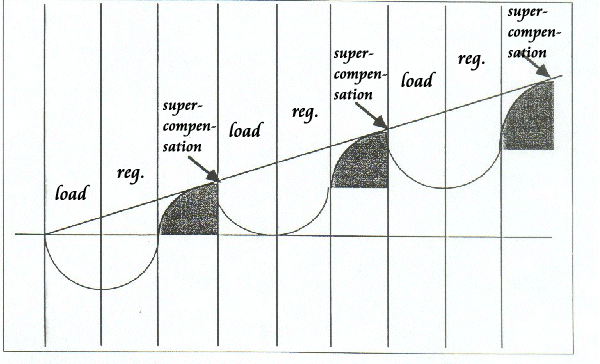Kevin (not real name) wrote me because he was confused. He follows some powerlifters, such as myself, but his training buddies told him he needed to train each body part, or even worse, each muscle, once a week in order to have “results”.
This is my reply:
Kevin, your friends were taught or self-taught in the bodybuilding philosophy. That doesn’t mean they are bodybuilders, but they learned to think resistance training in the “split” fashion, which claims a few right and a lot of wrong things. One right thing is that once you have given enough strength stimulus to the body, you need to give time for the body to respond to it. There are two things people mix and confuse in their minds: the first is the concept of supercompensation, the other is the need for rest.
Well, rest is easy: the hormonal response to training follows a circadian cycle. That means some hormones are released when you sleep. Sleep is extremely important for recovery. Why is it important to think about recovery? Because every strength training session or stimulus is a STRESS stimulus. The body needs to recover from it.
Now supercompensation is a little trickier, but not so much. Everything that is new to you triggers an alarm response and then you adapt to it. When you adapt, you become better at handling that same thing. When the “thing” is stressful (requires the body and mind to respond in order not to be harmed), there is an alarm phase, followed by a resistance phase and then, if things don’t go well (too much aggression, for example), an exhaustion phase.
Exercise is the same: after you workout, there will be an INHIBITORY PHASE in which the body will suffer the impact and recruit the resources to handle that stimulus. Next comes a SUPERCOMPENSATORY PHASE. Look at the senoid graphs bellow. This is what describes a training stimulus.
However, nobody knows exactly how long it takes to reach the supercompensatory optimum. That is because it changes according to type of stimulus, intensity, level of subject’s trainability, and thousands of other factors.
So this is a good thing about the bodybuilding philosophy: they understand “results” (in their case, muscle hypertrophy) will come if the body is allowed to supercompensate.
The wrong thing is thinking the body as if you could actually split it into parts and work each muscle in an isolated way. They try to do it. Most machines are designed to help such “isolation”. Bad news for them: isolation is impossible in a living organism. The most you can achieve with an “isolated exercise” is spoiling a natural gesture. They are trying to optimize the activation and strength output of the primary motor muscle, ONLY. They might… “optimize”, but isolation is impossible.
So, they are NOT working any muscle once a week.
And if you enjoy true strength gestures, the real lifts, then don’t worry: you will get the “results” with them just like your muscle-isolating buddies will, with the advantage that you will have fun, gain coordination and the stuff you do at the gym will transfer to anything you do in your life (we call that “neural transferability”).
The lifts – every one of them – require the contribution, either as primary motor muscles or synergists (the ones who are doing the most work in moving the joint and the ones who are working to stabilize it), of many, many muscles. Muscles work together, in what we call “muscle chains”. They never work alone. Also, at each stage of a lift, a different set of muscles, or chain, will take over the task of moving the weight – the rest of the muscles will not rest, they will go on working, but they won’t be the primary elements of this action.
Let me give you an example. Take the squat. The stupidest thing a person can say is that the squat is “for the legs”. You start the squat by unracking the bar. At this point you have abducted and depressed your scapulae (shoulder blades), contracted your pectorals in order to keep the thoracic spine neutral and stable, strongly contracted your abdominal muscles (all of them) and, obviously, all your paravertebral muscles. The squat starts with an “intention” on the hips. As you start flexing your hips, the rest of the muscles and joints will instantly start working to keep the GRAVITY LINE (the imaginary line that goes from the bar to the middle of your feet, or center of mass). You will flex your knees, the whole posterior chain (hamstring, glutes, lumbar muscles and even calves) will be activated to control deceleration. This is the “eccentric phase” of the lift. When you reach the lowest flexed position, you will immediately engage in the upward movement (“concentric phase”). Those muscles that were previously yielding, like all your quadriceps muscles and glutes (they were not resting!) will contract. They will contract and produce together the upward movement the whole time, but each set of muscles is more important in a different phase.
I could describe the bench press and the deadlift the same way: they require the participation of almost every muscle you know and many that you don’t know.
If doing the lifts involve all the muscles in the body, how do you organize your training to allow for proper supercompensation? So, do you only squat, bench and deadlift once a week? Usually people don’t, except in very rare occasions. Usually people squat twice a week, bench twice and deadlift once. Everything you do twice is done with a different focus each time. Say the first squat day is focused on strength. Your range of intensity will be over 80% (of your maximal effort). The other may be focused on volume, speed (power), technique.
But that’s another story, for another day. I hope to have answered your question.


